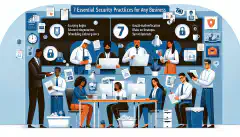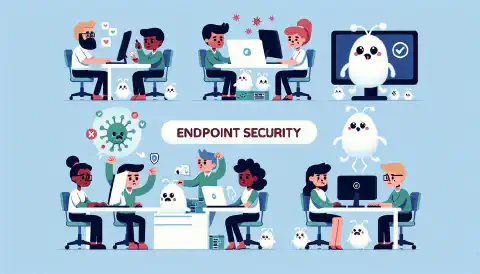Mastering Business Security: 7 Essential Practices for Fortified Defenses and Unyielding Success

Table of Contents
7 Essential Security Practices for Any Business
In today’s digital age, ensuring the security of your business is paramount. From physical security measures to cybersecurity protocols and data encryption practices, there are several essential steps that every business should take to protect its assets and sensitive information. Additionally, having a well-defined incident response plan is crucial for effectively addressing security breaches and minimizing their impact. Let’s explore the key takeaways from each of these areas.
Key Takeaways
- Implementing surveillance systems and access control measures can significantly enhance physical security.
- Regularly updating firewalls and antivirus software is essential for maintaining strong cybersecurity defenses.
- Employee training on cybersecurity best practices is a critical component of a robust security strategy.
- Data encryption, including SSL, file encryption, and database encryption, is vital for protecting sensitive information.
- Having a well-defined incident response plan with clear identification, activation, and analysis procedures is crucial for effective security management.
Physical Security Measures
Surveillance Systems
Surveillance Systems
Surveillance systems are essential for monitoring and recording activities in and around the business premises. They provide a visual record of events and can act as a deterrent to unauthorized activities. Regular maintenance and periodic checks ensure that the surveillance systems are functioning optimally.
- Ensure cameras cover all critical areas
- Regularly review footage for any unusual activity
- Consider integrating with access control systems for enhanced security
Tip: Position cameras strategically to cover entry points and high-traffic areas.
Access Control
Access control is a critical aspect of physical security, ensuring that only authorized individuals have entry to specific areas. It involves the use of keycards, biometric scanners, and access codes to restrict access to sensitive locations. Implementing a comprehensive access control system is essential for safeguarding physical assets and confidential information.
- Use of keycards, biometric scanners, and access codes
- Restrict access to sensitive locations
- Safeguard physical assets and confidential information
Tip: Regularly review and update access control permissions to maintain security and prevent unauthorized access.
Security Personnel
Surveillance Systems
Surveillance systems are essential for monitoring and recording activities in and around the business premises. They provide visual evidence of any security breaches and can act as a deterrent to potential intruders.
Access Control
Implementing strict access control measures ensures that only authorized personnel can enter restricted areas. This can be achieved through the use of key cards, biometric scanners, or PIN codes.
Security Personnel
Having trained security personnel on-site adds an extra layer of protection. They can respond to security incidents, conduct regular patrols, and provide a sense of security for employees and visitors.
Cybersecurity Protocols
Firewalls and Antivirus Software
Firewalls and antivirus software are essential components of cybersecurity. They act as the first line of defense against malicious attacks and unauthorized access. Regular updates to these systems are crucial to ensure they can effectively combat new threats and vulnerabilities.
Implementing a robust employee training program is vital to educate staff about cybersecurity best practices. This includes raising awareness about phishing attempts, social engineering tactics, and the importance of strong password management.
It is important to note that cybersecurity is an ongoing process, and businesses should continuously evaluate and improve their cybersecurity protocols to adapt to evolving threats.
Regular Software Updates
Regular software updates are essential for maintaining the security of your systems. They help to patch vulnerabilities and protect against the latest threats. Frequent updates ensure that your software is equipped to defend against emerging cyber threats. It’s important to establish a regular update schedule to ensure that all systems and applications are kept up to date.
- Implement a regular update schedule to ensure that all software and applications are updated in a timely manner.
- Consider using automated update tools to streamline the update process and minimize the risk of human error.
Tip: Prioritize critical security updates to address high-risk vulnerabilities and minimize the window of exposure to potential threats.
Employee Training
Employee Training
Employee training is a critical component of cybersecurity protocols. It ensures that employees are equipped with the knowledge and skills to identify and respond to cyber threats effectively. Training programs should cover topics such as phishing awareness, password security, and data handling best practices.
- Conduct regular security awareness sessions to keep employees informed about the latest cybersecurity trends and threats.
- Provide hands-on training for using security tools and reporting security incidents.
Tip: Encourage a culture of cybersecurity awareness by rewarding employees who demonstrate best security practices.
Data Encryption Practices
Secure Socket Layer (SSL)
Data encryption is a critical aspect of securing sensitive information. Secure Socket Layer (SSL) is a widely used encryption protocol that ensures secure communication over the internet. It provides a secure connection between a web browser and a server, safeguarding data transmission.
Implementing SSL encryption helps protect sensitive data from unauthorized access and interception. It is essential for securing online transactions, login credentials, and other confidential information.
Benefits of SSL Encryption:
| Benefits | Description |
|---|---|
| Data Protection | Encrypts data to prevent unauthorized access and maintain confidentiality. |
| Trust and Credibility | Builds trust with customers and partners by demonstrating a commitment to security. |
| Regulatory Compliance | Helps meet regulatory requirements and standards for data protection and privacy. |
Tip: Ensure that SSL certificates are regularly updated and validated to maintain their effectiveness.
File Encryption
File Encryption
File encryption is a critical security measure that protects sensitive data by encrypting individual files or folders. It ensures that only authorized users with the encryption key can access the contents, adding an extra layer of security to the data. Implementing file encryption helps prevent unauthorized access and data breaches, especially for confidential and proprietary information.
Benefits of File Encryption:
| Benefit | Description |
|---|---|
| Data Protection | File encryption safeguards data from unauthorized access and theft. |
| Compliance | Helps businesses comply with data protection regulations and industry standards. |
| Confidentiality | Preserves the confidentiality of sensitive information, such as financial records and customer data. |
File encryption is an essential component of a comprehensive data security strategy. It complements other encryption practices and contributes to a robust security posture. Organizations should prioritize the implementation of file encryption to safeguard their critical data assets.
Tip: Regularly review and update the file encryption methods and keys to maintain the effectiveness of this security measure.
Database Encryption
Data encryption is a critical aspect of securing sensitive information. Implementing Secure Socket Layer (SSL), file encryption, and database encryption helps protect data from unauthorized access. Encryption ensures that data is transformed into an unreadable format, making it inaccessible to unauthorized users. This provides an additional layer of security, especially for sensitive customer information and proprietary business data. Implementing encryption protocols is essential for compliance with data protection regulations and industry standards. It also mitigates the risk of data breaches and unauthorized data access. Organizations should regularly review and update their encryption practices to stay ahead of evolving security threats and vulnerabilities.
Incident Response Plan
Incident Identification
Incident Identification is a critical phase in the Incident Response Plan. It involves the initial detection and assessment of a security incident. This phase focuses on identifying the nature and scope of the incident, which is essential for determining the appropriate response. Timely and accurate incident identification is crucial for minimizing the impact of security breaches. It enables organizations to swiftly initiate the necessary actions to contain and mitigate the incident. Thorough documentation of the incident identification process is vital for post-incident analysis and improvement of response procedures.
- Implement a table for presenting structured, quantitative data. Ensure it’s succinct and formatted correctly in Markdown.
- Use a bulleted or numbered list for less structured content, like steps, qualitative points, or a series of related items.
It’s important to establish clear protocols for incident identification to ensure a swift and effective response to security incidents.
Response Team Activation
After the Response Team Activation, it is crucial to swiftly move into action to address the incident. This involves coordinating with relevant stakeholders, including IT personnel, security teams, and management.
Key steps in the incident response process include:
- Incident Identification: Promptly recognizing and verifying the occurrence of a security incident.
- Response Team Activation: Mobilizing the designated response team to assess and mitigate the incident.
- Post-Incident Analysis: Conducting a thorough review of the incident to identify root causes and improve future response strategies.
Tip: Regularly conduct drills and simulations to ensure the response team is well-prepared to handle various security incidents effectively.
Post-Incident Analysis
After the Post-Incident Analysis, it is crucial to implement an effective incident response plan to address and mitigate future security incidents. This plan should include clear incident identification procedures to quickly recognize security breaches or threats. Additionally, the response team activation process should be well-defined, outlining the roles and responsibilities of each team member. A thorough post-incident analysis is essential for learning from the incident and improving security measures. Consider implementing a structured incident response table to outline the steps and actions required during a security incident. This table should include key information such as incident severity, response actions, and responsible team members. Remember to regularly review and update the incident response plan to align with evolving security threats and business needs. An effective incident response plan is a critical component of a comprehensive security strategy.
Conclusion
In conclusion, the security of any business is paramount for its success and sustainability. By implementing physical security measures such as surveillance systems, access control, and security personnel, businesses can protect their premises and assets. Additionally, robust cybersecurity protocols including firewalls, antivirus software, regular software updates, and employee training are essential for safeguarding digital assets and sensitive information. Furthermore, data encryption practices such as Secure Socket Layer (SSL), file encryption, and database encryption play a crucial role in securing data from unauthorized access. Lastly, having a well-defined incident response plan that includes incident identification, response team activation, and post-incident analysis is vital for mitigating the impact of security breaches. Businesses that prioritize these essential security practices are better equipped to prevent and respond to security threats, ensuring the safety and integrity of their operations.
Frequently Asked Questions
What is the importance of physical security measures in a business?
Physical security measures are essential for protecting a business’s premises, assets, and personnel from unauthorized access, theft, and other physical threats. They help create a safe and secure environment for employees and customers.
Why are cybersecurity protocols important for businesses?
Cybersecurity protocols are crucial for safeguarding a business’s digital assets, sensitive information, and systems from cyber threats such as malware, hacking, and data breaches. They help minimize the risk of cyber attacks and protect the integrity of business operations.
What are the benefits of data encryption practices for businesses?
Data encryption practices help businesses secure their sensitive data, communications, and transactions by encoding information in a way that only authorized parties can access and understand. This helps prevent unauthorized access and protects the confidentiality of business data.
How does an incident response plan benefit a business?
An incident response plan enables businesses to effectively and efficiently respond to security incidents, minimize the impact of breaches or threats, and restore normal operations. It helps mitigate potential damages and ensures a swift and coordinated response to security incidents.
What role does employee training play in cybersecurity protocols?
Employee training plays a critical role in cybersecurity protocols by educating employees about best practices, security policies, and potential threats. It helps create a culture of security awareness, reduces human errors, and strengthens the overall cybersecurity posture of the business.
What are the key components of a robust surveillance system?
A robust surveillance system includes high-quality cameras, motion detection, remote monitoring capabilities, and secure data storage. It provides real-time monitoring, evidence collection, and deterrence against unauthorized activities, enhancing the physical security of the business premises.






